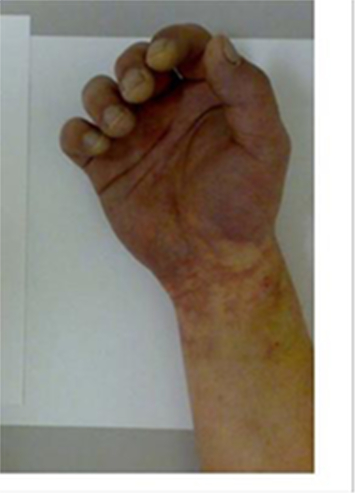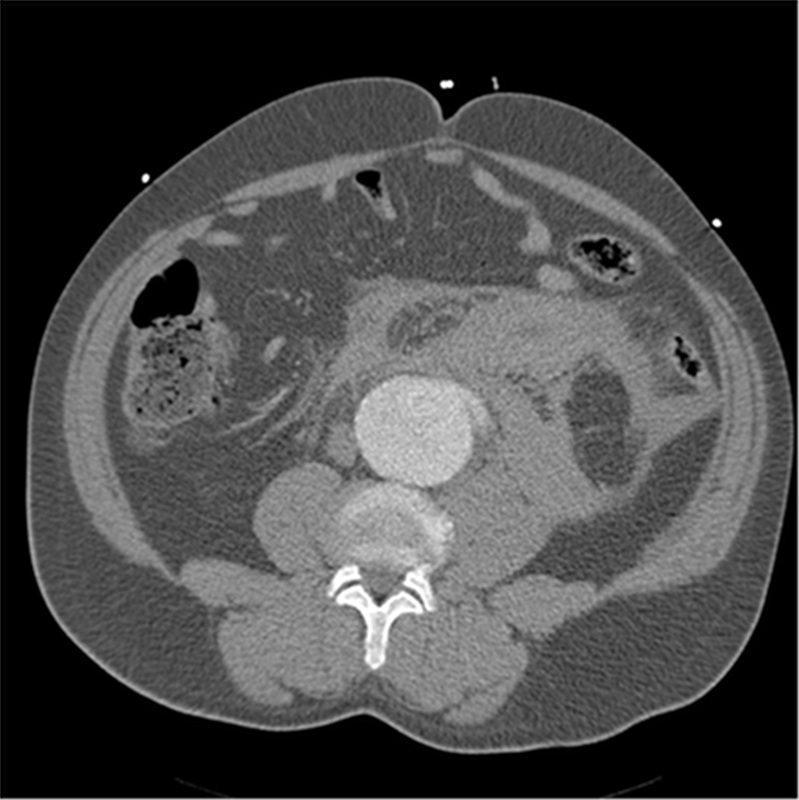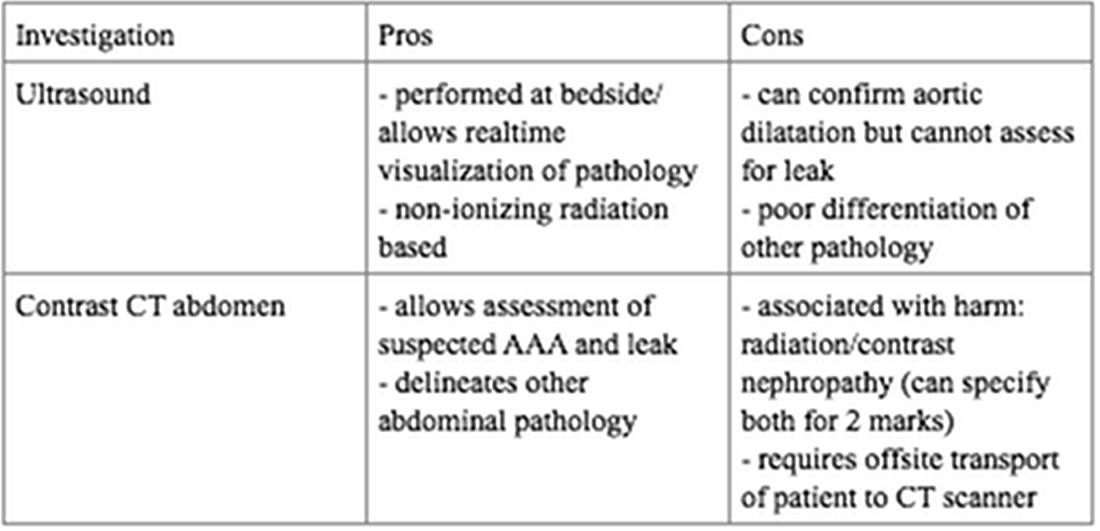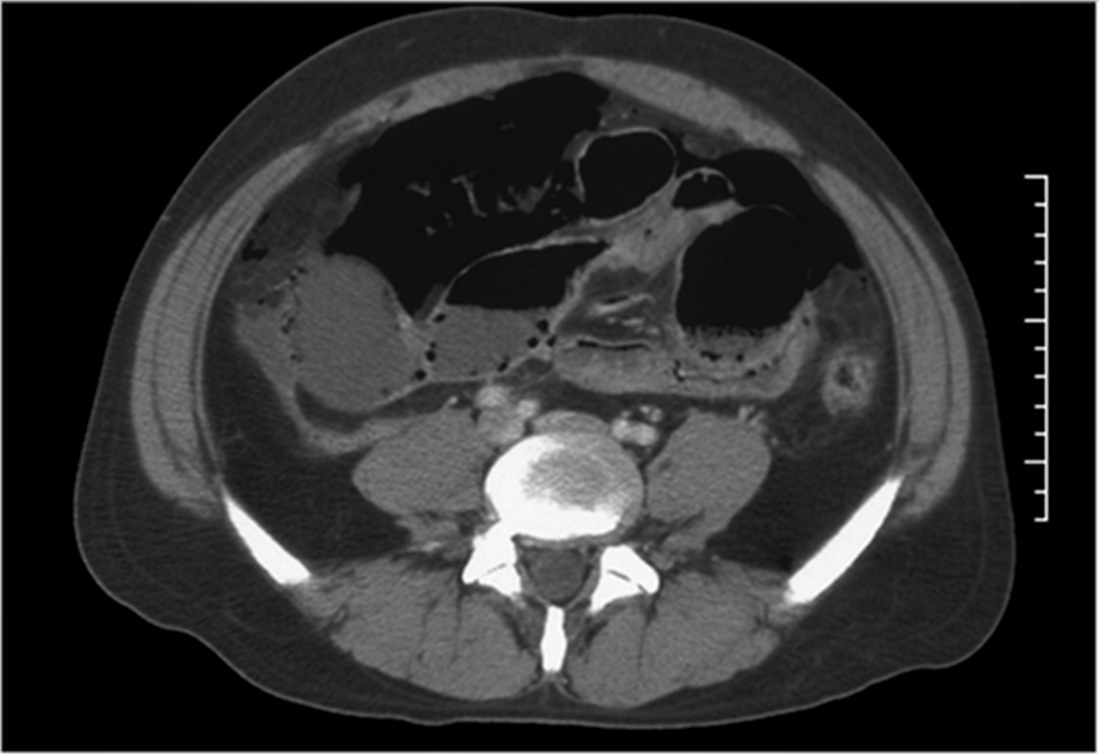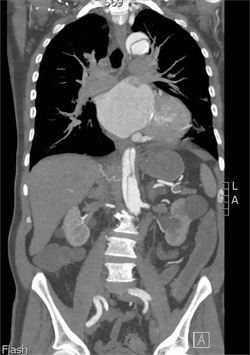MODULE Five short answer questions.
saq 1.
A 32 year old man presents to your emergency department with complaining of pain and parasthesiae in the right hand. There is no history of trauma.
A clinical image of the hand is shown below.
A clinical image of the hand is shown below.
Question 1. (3 marks)
What are the major abnormalities shown and what is the differential diagnosis?
Must include:
- mottled/discoloured hand
- extending over all 5 fingers and proximally to the wrist joint
- concerning for acute limb ischaemia
Question 2. (5 marks)
Give 2 features you will inquire about on history and 3 features you will seek on examination.
History must include:
- history of injecting drug use
- history of accelerated vascular disease or atrial fibrillation
Examination must include
- assessment of peripheral pulses
- assessment of capillary refill
Plus either
- temperature of right hand compared to left
- assessment for track marks/injection site
Question 3. (2 marks)
What investigation will you perform in this patient?
Must include
- CT angiogram of the upper limb
What are the major abnormalities shown and what is the differential diagnosis?
Must include:
- mottled/discoloured hand
- extending over all 5 fingers and proximally to the wrist joint
- concerning for acute limb ischaemia
Question 2. (5 marks)
Give 2 features you will inquire about on history and 3 features you will seek on examination.
History must include:
- history of injecting drug use
- history of accelerated vascular disease or atrial fibrillation
Examination must include
- assessment of peripheral pulses
- assessment of capillary refill
Plus either
- temperature of right hand compared to left
- assessment for track marks/injection site
Question 3. (2 marks)
What investigation will you perform in this patient?
Must include
- CT angiogram of the upper limb
saq 2.
An 85 year old man presents with an episode of syncope preceded by sudden onset acute abdominal pain. His daughter tells you he has a history of an “artery problem” in the abdomen. The patient’s vital signs are:
HR 114 /min
BP 95/52 mmHg
RR 24 /min
Sats 98% RA
T 37.1 oC
Question 1. (3 marks)
What features on examination will make you suspect a bleeding abdominal aortic aneurysm?
Must include:
- large pulsatile abdominal mass
- absent or different femoral pulses
- Grey-Turner’s or Cullen’s sign suggesting retroperitoneal bleeding
Question 2. (4 marks)
A CT scan of the patient’s abdomen is performed, and an image is shown below.
What is the scan that has been performed, what are the major abnormalities and what is the diagnosis?
HR 114 /min
BP 95/52 mmHg
RR 24 /min
Sats 98% RA
T 37.1 oC
Question 1. (3 marks)
What features on examination will make you suspect a bleeding abdominal aortic aneurysm?
Must include:
- large pulsatile abdominal mass
- absent or different femoral pulses
- Grey-Turner’s or Cullen’s sign suggesting retroperitoneal bleeding
Question 2. (4 marks)
A CT scan of the patient’s abdomen is performed, and an image is shown below.
What is the scan that has been performed, what are the major abnormalities and what is the diagnosis?
Must include:
- scan: axial contrast scan of the aorta
Abnormalities
- dilated abdominal aorta
- large retroperitoneal haematoma
Diagnosis
- AAA with large retroperitoneal haemorrhage.
Question 3. (3 marks)
What actions will you now take?
Must include:
- ensure large gauge access
- urgent vascular surgery referral & notification of OT
- x-match 6 units of blood
- scan: axial contrast scan of the aorta
Abnormalities
- dilated abdominal aorta
- large retroperitoneal haematoma
Diagnosis
- AAA with large retroperitoneal haemorrhage.
Question 3. (3 marks)
What actions will you now take?
Must include:
- ensure large gauge access
- urgent vascular surgery referral & notification of OT
- x-match 6 units of blood
saq 3.
A 75 year old man presents with sudden onset central abdominal pain. He has no known medical history of note. His vital signs are:
HR 99 /min
BP 115/60 mmHg
RR 18 /min
Sats 99% RA
T 37.1 oC
Your registrar sees the patient and returns to you telling you she suspects a leaking abdominal aortic aneurysm.
Question 1. (8 marks)
For each listed imaging type give 2 advantages and 2 disadvantages of the modality for investigation of suspected leaking AAA. (8 marks)
1. Ultrasound
2. Contrast CT of the abdomen.
HR 99 /min
BP 115/60 mmHg
RR 18 /min
Sats 99% RA
T 37.1 oC
Your registrar sees the patient and returns to you telling you she suspects a leaking abdominal aortic aneurysm.
Question 1. (8 marks)
For each listed imaging type give 2 advantages and 2 disadvantages of the modality for investigation of suspected leaking AAA. (8 marks)
1. Ultrasound
2. Contrast CT of the abdomen.
Question 2. (2 marks)
Because of pre-existing renal impairment, the radiology department insists on performing a non contrast CT scan prior to the injection of contrast. A slice from this CT is shown below.
What is the major finding and diagnosis?
Must include:
- Pneumatosis intestinalis
Diagnosis: ischaemic mesentery.
- Pneumatosis intestinalis
Diagnosis: ischaemic mesentery.
saq 4.
A 55 year old man presents with tearing onset chest pain radiating through to his back. He looks distressed with the pain, and is pale and diaphoretic.
The patient’s vital signs are:
HR 120 /min
BP 190/110 mmHg
RR 25 /min
Sats 99% RA
T 37.2 oC
Question 1. (3 marks)
Give three features on clinical examination that would make you suspect dissection of the ascending aorta.
Must include: (2 marks)
- Systolic BP difference of more than 20mmHg between R and L arm
- Radio-radial pulse delay
Plus one of (1 mark total)
- L sided weakness
- R sided Horner’s syndrome
- R sided limb ischaemia
Question 2. (2 marks)
A contrast CT scan is performed and an image is shown below.
What does the image show?
The patient’s vital signs are:
HR 120 /min
BP 190/110 mmHg
RR 25 /min
Sats 99% RA
T 37.2 oC
Question 1. (3 marks)
Give three features on clinical examination that would make you suspect dissection of the ascending aorta.
Must include: (2 marks)
- Systolic BP difference of more than 20mmHg between R and L arm
- Radio-radial pulse delay
Plus one of (1 mark total)
- L sided weakness
- R sided Horner’s syndrome
- R sided limb ischaemia
Question 2. (2 marks)
A contrast CT scan is performed and an image is shown below.
What does the image show?
Must include:
- dissection flap visible in both aortic arch (1 mark) and descending aorta (1 mark)
Question 3. (2 marks)
Is there sufficient diagnostic information on this CT to definitively determine the patient’s management strategy? Why or why not?
Must include:
No. It is unclear whether the dissection involves the ascending aorta or not. The management of Stanford A dissections (involving ascending aorta) is aortic root replacement, while Stanford B dissections are managed medically.
Question 4. (3 marks)
Describe your immediate actions to manage this patient.
Must include:
- reduction in SBP and HR aiming 100-120mmHg & 60bpm using labetolol 20mg Q10 minutes (1 mark for endpoint, 1 for correct drug)
- urgent cardiothoracic consult (1 mark)
- dissection flap visible in both aortic arch (1 mark) and descending aorta (1 mark)
Question 3. (2 marks)
Is there sufficient diagnostic information on this CT to definitively determine the patient’s management strategy? Why or why not?
Must include:
No. It is unclear whether the dissection involves the ascending aorta or not. The management of Stanford A dissections (involving ascending aorta) is aortic root replacement, while Stanford B dissections are managed medically.
Question 4. (3 marks)
Describe your immediate actions to manage this patient.
Must include:
- reduction in SBP and HR aiming 100-120mmHg & 60bpm using labetolol 20mg Q10 minutes (1 mark for endpoint, 1 for correct drug)
- urgent cardiothoracic consult (1 mark)
saq 5.
A 26 year old motor bike rider has presented to your department 3 hours previously after sustaining a closed mid tibial and fibular fracture, which has been reduced and placed in a cast. The nurse looking after the patient has asked you to review him because he is complaining of increasing pain.
Question 1. (2 marks)
What is the most important diagnosis that you now need to evaluate for?
Must include:
compartment syndrome
Question 2.
What features will you seek on history and examination? (8 marks)
Must include:
History: (3 marks)
- features of compartment syndrome
parasthesiae
deep burning pain
increasing pain despite adequate analgesia
Exam (5 marks)
Must mention would remove cast for the examination (1 mark)
Pain with passive stretch of muscles in the affected compartment (1 mark)
Plus: (3 of the following for 1 mark each)
Tense compartment with a firm "wood-like" feeling
Pallor from vascular insufficiency
Diminished sensation
Paralysis
Question 1. (2 marks)
What is the most important diagnosis that you now need to evaluate for?
Must include:
compartment syndrome
Question 2.
What features will you seek on history and examination? (8 marks)
Must include:
History: (3 marks)
- features of compartment syndrome
parasthesiae
deep burning pain
increasing pain despite adequate analgesia
Exam (5 marks)
Must mention would remove cast for the examination (1 mark)
Pain with passive stretch of muscles in the affected compartment (1 mark)
Plus: (3 of the following for 1 mark each)
Tense compartment with a firm "wood-like" feeling
Pallor from vascular insufficiency
Diminished sensation
Paralysis
